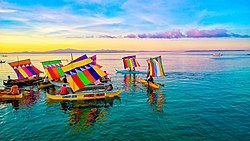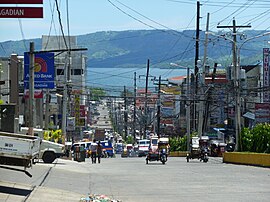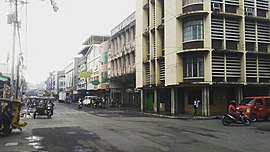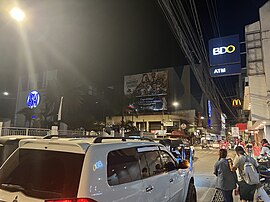Zamboanga Peninsula
Zamboanga Peninsula
Peninsula de Zamboanga Lawis sa Zamboanga | |
|---|---|
 Vintas of Zamboanga | |
 Location in the Philippines | |
| Coordinates:7°50′N122°25′E/ 7.83°N 122.42°E | |
| Country | Philippines |
| Island group | Mindanao |
| Regional center | Zamboanga City(until 2004) Pagadian(since 2004) |
| Largest city | Zamboanga City |
| Area | |
| • Total | 17,056.73 km2(6,585.64 sq mi) |
| Highest elevation | 1,532 m (5,026 ft) |
| Population (2020 census)[1] | |
| • Total | 3,875,576 |
| • Density | 230/km2(590/sq mi) |
| Time zone | UTC+8(PST) |
| ISO 3166 code | PH-09 |
| Provinces | |
| Independent cities | |
| Component cities | |
| Municipalities | 67 |
| Barangays | 1,904 |
| Cong. districts | 8 |
| Languages | |
| GDP(2023) | ₱531.7 billion $9.56 billion[2] |
| Growth rate | |
| HDI | |
| HDI rank | 16th in the Philippines(2019) |
Zamboanga Peninsula(Cebuano:Lawis sa Zamboanga.;Chavacano:Peninsula de Zamboanga;Filipino:Tangway ng Zamboanga) is anadministrative regionin thePhilippines,designated asRegion IX.It consists of threeprovinces(Zamboanga del Norte,Zamboanga SibugayandZamboanga del Sur) including four cities (Dapitan,Dipolog,Pagadian,Isabela) and the highly urbanizedZamboanga City.The region was previously known asWesternMindanaobefore the signing of Executive Order No. 36 of 2001. The city of Zamboanga was designated as the regional center until Pagadian was designated as its new regional center, although Zamboanga City remains the region's cultural, commercial, economic, and educational center.
Designation[edit]
| Area | Province | Designation | Remarks |
|---|---|---|---|
| Pagadian City | Zamboanga del Sur | Regional Center
Component City |
Provincial CapitalofZamboanga del Sur |
| Zamboanga City | Zamboanga del Sur(statistical purposes only) | Commercial and Industrial Center
(Metropolitan Center, 2028)[3] *Highly Urbanized City |
In 2028, Zamboanga City's population is projected to hit the 1,200,000 mark which classifies the city as aMetropolitan Citybased on NEDA's classification.[4] |
| Dipolog City | Zamboanga del Norte | Component city | Provincial CapitalofZamboanga del Norte |
| Ipil | Zamboanga Sibugay | Municipality | Provincial CapitalofZamboanga Sibugay |
| Dapitan City | Zamboanga del Norte | Component city | |
| Isabela City | Basilan | Component city | In 2028, Isabela City's population is projected to surpass Dipolog City's population in the same timeframe. |
Zamboanga Peninsula Regional Development Plan 2023–2028.[5]
History[edit]
Ancient era[edit]
During the ancient era, the Zamboanga peninsula was a vast territory home to various ethnic groups – the largest of which was theSubanen people.Later on, the southern coastal areas of the region were under the influence of theJavaneseMajapahit Empire,although the empire never did conquer the area.
Sultanate of Maguindanao era[edit]
In the 14th century, theSultanate of Suluruled the southwestern sections of the peninsula. By the late 15th century and early 16th century,Malaymissionaries further spread Islam in the southern Philippines.Sharif Kabungsuwan,a Johore-born missionary ofMalayandArabdescent established theSultanate of Maguindanao,which the entire island ofMindanaois named after. The sultanate also occupied the entire island except present-day Caraga region, stretching from the Zamboanga Peninsula to Davao Oriental, while the Sultanate of Sulu lost its territories in Zamboanga. Maguindanao's sultans provided Mindanao fierce armed resistance against the Spanish occupation, especially under the lead ofMuhammad Kudarat.They soon allied themselves with the Sulu sultanate. The Muslim natives of the region were collectively known asMorosby the Spanish, meaning "Moor", though the Iberian Moors and the Philippine Muslims had little cultural connection outside of followingIslam.A large chunk of theSpanish–Moro conflict,the war between the Spanish and Mindanao's Muslim natives took place in the Zamboanga Peninsula.
Spanish rule[edit]
In 1569 Zamboanga was chosen as the site of the Spanish settlement and garrison on La Caldera (now called Barrio Recodo). Zamboanga was one of the main strongholds in Mindanao, supporting colonizing efforts in the south of the island and making way for Christian settlements. It also served as a military outpost, protecting the island against foreign invaders and Moro pirates and their Chinese allies. The province, named and centered onZamboanga Citywas partly founded by Peruvian soldiers brought bySebastián Hurtado de Corcuera.[6]
The Zamboanga Peninsula played a central role in theSpanish–Moro conflict.It was the site of constant battling between Spanish soldiers and Moro pirate raids. While the Spanish successfully established churches in the region, they suffered heavily at the hands of Moro raiders, and had to repeatedly withdraw from the region. While the Spanish achieved a tactical victory by launching several attacks against theSultanate of Sulu,constant fighting and attacks persisted, giving the Moros a psychological victory.
Province of Zamboanga[edit]
After the United States annexed theSpanish East Indiesin 1898, the peninsula hosted a briefly independent state called theRepublic of Zamboanga.It was incorporated by theInsular Governmentinto theMoro Province,which consisted of the central and western parts ofMindanaoand theSulu Archipelago.The name and status of Moro Province were changed to theDepartment of Mindanao and Suluon August 16, 1916, causing Zamboanga to become a separate province.
In 1942, the Zamboanga Peninsula along with the rest of the Philippine Islands wasoccupiedby theEmpire of Japanat the beginning of theSecond World War.The Peninsula was liberated in 1945 by jointAmericanandPhilippine Commonwealthforces fighting against theImperial Japanese Army.
On June 6, 1952, the province waspartitionedintoZamboanga del NorteandZamboanga del Sur,while the chartered city ofZamboangabecame part of Zamboanga del Sur.
Region[edit]
Together with theSulu Archipelago,the provinces that formerly made up Zamboanga Province were re-organised into Region IX by order of Presidential Decree No. 1 as part of the Integrated Reorganization Plan ofPresidentFerdinand Marcos,that was signed on September 24, 1972.[7]
From 1975 to 1989, the old Region IX (Western Mindanao) was further divided into two sub-regions by Presidential Decree No. 8233 dated August 21, 1975.[8]Sub-Region IX-A consisted ofBasilan,SuluandTawi-TawiwithJolo, Sulu,as the sub-regional center, while Sub-Region IX-B consisted of the provinces ofZamboanga del Norte,Zamboanga del SurandZamboanga Sibugay,with the chartered city ofZamboanga Cityas the sub-regional centre.
Present[edit]
In 2001,Zamboanga Sibugay,was created from the province of Zamboanga del Sur withIpilas the seat of government with the virtue of Republic Act No. 8973.
In the same year, the residents ofBasilanopted to join theAutonomous Region in Muslim Mindanao(ARMM) in a plebiscite. However, the citizens of the capital,Isabela,did not want to join so the city remained a part of this region as a result of Executive Order No. 36 last until 2014 only.
In 2004,Pagadianofficially became the Regional Center for Region IX- Zamboanga Peninsula, despite opposition fromZamboanga City,the former Regional Center.
Regional center issue[edit]
In 1978, Presidential Decree No. 1555 transferred Region IX's regional center fromJolo, SulutoZamboanga City.[9]
Executive Order (EO) No. 429 was issued in 1990 by PresidentCorazon Aquinowhich provided for the reorganization of the administrative regions in Mindanao. It declared that Western Mindanao would comprise Zamboanga City, Lanao del Norte,Misamis Occidental,Zamboanga del Sur, Zamboanga del Norte, Basilan, and the cities comprising those provinces. It also declared that Pagadian City shall serve as the new regional center.[10]
In 1996, PresidentFidel Ramosissued EO No. 325 which reorganized the Regional Development Councils (RDCs). The Implementing Rules and Regulations (IRR) of EO No. 325 also declared Zamboanga City as the regional center in Western Mindanao.[11]
In 2001, PresidentGloria Macapagal Arroyosigned EO No. 36 which reorganized and renamed Western Mindanao to Zamboanga Peninsula. It was silent on the issue of regional government centers.[11][12]Memorandum Circular No. 75, signed in 2004 by Executive SecretaryEduardo Ermita,directed the transfer of regional offices from Zamboanga City to Pagadian citing EO 429 as its legal basis.[13]
A moratorium on the transfer under Memorandum Circular No. 11 was issued on December 22, 2010, citing the high economic and social costs that the employees were experiencing in maintaining two residences and in fully transferring to Pagadian. It further directed all regional offices that are already in Pagadian to continue their operations.[14]
On March 3, 2011, the Regional Development Council IX endorsed Zamboanga City as the regional center of Zamboanga Peninsula.[15][16]This endorsement remains unacted to date.
National Economic and Development AuthorityRegional Director Arturo Valero stated that “even if Zamboanga City is not the regional center, the city will still grow” and that the city should better focus on being a commercial and industrial center.[17]
On June 30, 2020, Malacañang, under President Rodrigo Duterte, lifted Memorandum Circular No. 11 (issued by previous administration), allowing the remaining regional offices to transfer to Pagadian after almost 15 years. However, the departments of Trade and Industry, Tourism, and Labor and Employment will remain in Zamboanga City, being the region's center of commerce and industry.
On April 20, 2023, aMoratoriumwas imposed on the transfer of regional government offices from Zamboanga City to Pagadian City. The Dalipe Brothers have lobbied for the suspension, arguing that there is a need to reevaluate the implementation of the full transfer of the offices relative to the ongoing devolution of national government offices.
According to the Palace memorandum, the Moratorium also intends to provide an opportunity to study and re-assess the justifications for, as well as the implications of the transfer of regional offices to Pagadian City. Government agencies, it said, are enjoined to suspend the relocation of their regional offices from Zamboanga City to Pagadian City "pending the study of the political, economic, and social implications of said transfer."
"The regional offices that are already in Pagadian City shall continue to operate." The circular added. Dalipe said six regional government offices shall remain in Zamboanga City.[18]
Following the newly imposedmoratorium,both Mayor Dalipe and Majority Leader Congressman Mannix Dalipe vowed to exhaust all measures to reverse the ongoing transfer and maintain Zamboanga City as the regional center of Zamboanga Peninsula.[19]
Geography[edit]
The region is located on the western part of the island ofMindanao,that lies between theMoro Gulf(part of theCelebes Sea) and theSulu Sea.Along the shores of the peninsula are numerous bays and islands of varying sizes. The peninsula is connected to the rest of Mindanao through anisthmussituated betweenPanguil Bayand Pagadian Bay. The region consists of the three Zamboanga provinces and the highly urbanized independent city of Zamboanga, and the boundary between the peninsula and mainland is artificially marked by the border between the provinces ofZamboanga del SurandLanao del Norte.The province ofMisamis Occidentaloccupies the northeast corner of the geographic peninsula, but is part of theNorthern Mindanaoadministrative region, which also includesMisamis Orientalon the Mindanao mainland, formerly both part of pre-1929Misamis (province)along the shores ofIligan Bay.
Administrative divisions[edit]
Provinces[edit]
Zamboanga Peninsula comprises 3 Provinces; 1 independent, chartered and highly urbanizedcity;3 component cities; 67municipalitiesand 1,904barangays.
| ProvinceorCity | Capital | Population(2020)[20] | Area[21] | Density | Cities | Muni. | Barangay | |||||
|---|---|---|---|---|---|---|---|---|---|---|---|---|
| km2 | sq mi | /km2 | /sq mi | |||||||||
| Zamboanga del Norte | Dipolog City | 27.0% | 1,047,455 | 7,300.11 | 2,818.59 | 140 | 360 | 2 | 25 | 691 | ||
| Zamboanga del Sur | Pagadian City | 27.1% | 1,050,668 | 4,484.21 | 1,731.36 | 230 | 600 | 1 | 26 | 681 | ||
| Zamboanga Sibugay | Ipil | 17.3% | 669,840 | 3,481.28 | 1,344.13 | 180 | 470 | 0 | 16 | 389 | ||
| Zamboanga City | † | — | 25.2% | 977,234 | 1,414.70 | 546.22 | 690 | 1,800 | 1 | — | 98 | |
| Isabela City | ‡ | — | 3.4% | 130,379 | 233.73 | 90.24 | 560 | 1,500 | 1 | — | 45 | |
| Total | 3,875,576 | 16,904.03 | 6,526.68 | 230 | 600 | 5 | 67 | 1,904 | ||||
| ||||||||||||
Governors and vice governors[edit]
| Province | Image | Governor | Political Part | Vice Governor | |
|---|---|---|---|---|---|

|
Rosalina Jalosjos | Nacionalista/APP | Julius Napigquit | ||

|
Victor Yu | PDP–Laban | Roseller Ariosa | ||

|
Dulce Ann Hofer | PDP–Laban | Rey Andre Olegario | ||
Cities[edit]

Isabelais acomponent cityand the former capital of the province ofBasilan.In 2017, the seat of Basilan's government was moved toLamitan.Isabela continues to be under the jurisdiction of Basilan for the administration of provincially devolved services and functions, but for the administration of regional services, the city is part of the Zamboanga Peninsula Region while the rest of Basilan is under the authority of theBangsamoroAutonomous Region in Muslim Mindanao.
Isabela was the southernmost outpost of the Spanish in the Philippines until the fall of Jolo in 1878. It hosted Catholic residents since 1637, and a Spanish Fort (destroyed in World War II) since 1848, It also was the primary naval base of the Spanish in Mindanao until 1899. Named afterQueen Isabella II,the city is the southernmost predominantly Christian enclave of the Philippines, and serves as an entry point for trade and commerce of Basilan island.[22]
Dapitanis also known as the "Shrine City in the Philippines" because it was the place whereJosé Rizal,the National Hero, was exiled.[23]It is also known for the old St. James Parish and the beach resort of Dakak.
Dipolog,capital ofZamboanga del Norte,is known for their abundance of orchids, thus it is called "Orchid City of the South" or "Orchid City". They have their nature spots and historical spots, such asDipolog Cathedral,Dipolog Boulevard,Cogon Park, Japanese Park, Plaza Magsaysay, the Sungkilaw Falls, and the 3,003 steps to Linabo Peak.
Pagadianis known as the "Little Hong Kong of the South" because of its topographical feature that is reminiscent ofHong Kong.It also has an affluent Chinese community that officially celebrates the Chinese Lunar New Year.[24]
Zamboanga Cityis the onlyIndependent,charteredcity andhighly urbanized cityin the region. The city is the lone member ofBIMP-EAGAin the Zamboanga Peninsula. Zamboanga City generates more than half of the economy of the region. It also has the largest airport and seaport and the city in the region with most investors.
Additionally, the region is also highlighted by its three key municipalities, namelySindangan,Ipil,andMolave,all of which arefirst class municipalitiesin the provinces of Zamboanga del Norte, Zamboanga Sibugay, and Zamboanga del Sur, respectively. Sindangan has been vying for cityhood status since 2019, following a rapid increase of its populace and economic dynamism in the recent preceding years.
- †Regional center
| City | Population(2020)[20] | Area | Density | City class | Province | ||
|---|---|---|---|---|---|---|---|
| Dapitan | 85,202 | 390.53 | 150.78 | 220 | 570 | Component | Zamboanga del Norte |
| Dipolog | 138,141 | 241.13 | 93.10 | 570 | 1,500 | Component | Zamboanga del Norte |
| Isabela | 130,379 | 140.7 | 54.3 | 930 | 2,400 | Component | Basilan |
| †Pagadian | 210,452 | 378.80 | 146.26 | 560 | 1,500 | Component | Zamboanga del Sur |
| Zamboanga City | 977,234 | 1,414.7 | 546.2 | 690 | 1,800 | Highly urbanized | Zamboanga del Sur |
Demographics[edit]
| Year | Pop. | ±% p.a. |
|---|---|---|
| 1903 | 98,086 | — |
| 1918 | 147,333 | +2.75% |
| 1939 | 355,984 | +4.29% |
| 1948 | 521,941 | +4.34% |
| 1960 | 900,730 | +4.65% |
| 1970 | 1,334,446 | +4.00% |
| 1975 | 1,541,459 | +2.93% |
| 1980 | 1,821,751 | +3.40% |
| 1990 | 2,280,460 | +2.27% |
| 1995 | 2,567,651 | +2.25% |
| 2000 | 2,831,412 | +2.12% |
| 2007 | 3,230,094 | +1.83% |
| 2010 | 3,407,353 | +1.96% |
| 2015 | 3,629,783 | +1.21% |
| 2020 | 3,875,576 | +1.30% |
| Source: Philippine Statistics Authority[1][25] | ||
Economy[edit]
The Philippine Statistics Authority (PSA) released the first ever report of the Provincial Product Accounts (PPA) of Zamboanga Peninsula covering the period 2018 to 2022. The release covers three provinces, namely,Zamboanga del Norte,Zamboanga del Sur,andZamboanga Sibugay,as well as one Highly Urbanized City (HUC), City of Zamboanga, and one component city, City of Isabela.[34]
The PPA results showed that in 2022, theCity of Zamboanga accounted for 32.6percent of the total economy of Zamboanga Peninsula. This was followed by Zamboanga del Norte with a share of 26.8 percent, Zamboanga del Sur with 23.7 percent, and Zamboanga Sibugay with 14.1 percent. Meanwhile, City of Isabela recorded a 2.7 percent share.
In terms of growth rate, all economies in the region expanded in 2022, withZamboanga Sibugay recording the fastest growth of 8.6percent, followed by City of Zamboanga with a growth rate of 8.1 percent. Zamboanga Sibugay and City of Zamboanga recorded growths faster than the region's economic growth of 7.5 percent. On the other hand, City of Isabela, Zamboanga del Norte, and Zamboanga del Sur posted growth rates of 7.21 percent, 7.17 percent, and 6.5 percent, respectively, which were lower than the region's economic performance in 2022.
The region has the first export-processing zone in Mindanao. Farming and fishing are the main economic activities of the region. It also has rice and corn mills, oil processing, coffee berry processing and processing of latex from rubber. Its home industries include rattan and furniture craft, basket making, weaving and brass work.Dipologis home to a number of Bottled Sardines Companies which are being exported abroad. Dakak Park and Beach Resort can be found inDapitanit is one of the most visited places in the region along with Gloria's Fantasyland the first and only theme park in Vismin.
WhilePagadian Cityis the region's new Regional Center,Zamboanga City’s economy remains to be the most robust and fastest growing in the region.[35]
Resources[edit]
The region has vast forest resources and previously used to export logs, lumber, veneer and plywood. Mineral deposits include gold, chromite, coal, iron, lead, and manganese. Among its non-metallic reserves are coal, silica, salt, marble, silica sand, and gravel. Its fishing grounds are devoted to commercial and municipal fishing. It has also aqua farms for brackish water and freshwater fishes.
Area of Growth[edit]
The economic fulcrum of the region lies at the center of the peninsula that is the area connectingIpilandLiloy.Along with its premiere towns ofSindanganandMolave,it has the fastest economic activity of the region. The 50-kilometer link between the north and the south would act as the main artery of economy in the region.
Shopping malls[edit]
Lists of national malls in Zamboanga Peninsula (Operating/Under-construction)[edit]
| Name | Location | Gross floor area | Opened | Status | Remarks |
|---|---|---|---|---|---|
| Gaisano Capital Pagadian | Rizal Avenue,Pagadian,Zamboanga del Sur | Unknown | 2008 | Operating | First national-scale and Gaisano mall in the region. |
| CityMall Tetuan | Don Alfaro Street, Tetuan,Zamboanga City | 15,344 m2 | 2015 | Operating | The first CityMall in the region and in Zamboanga City. |
| KCC Mall de Zamboanga | Camins Avenue,Zamboanga City | 162,000 m2 | 2015 | Operating | The first KCC mall and the current largest mall in the region. |
| CityMall Dipolog | Sto. Filomena,Dipolog,Zamboanga del Norte | 12,862 m2 | 2018 | Operating | The first CityMall inZamboanga del Norteand second in Zamboanga Peninsula. Also the first in the region fully owned byDoubleDragonwithSM Savemoreas its anchor tenant and has two cinemas. |
| Grand CityMall Guiwan | MCLL Highway, Guiwan,Zamboanga City | TBA | 2024 | Under-construction | The third CityMall in the region and the second in Zamboanga City. It is set to become the biggest CityMall in the country. |
| SM City Mindpro | La Purisima Street,Zamboanga City | 59,383 m2 | 2020 | Operating | The first SM Supermall in the region, currently the 2nd largest mall in the region. It will become the 3rd largest mall in the region afterSM City Zamboanga’s opening. |
| Gaisano Grand Ipil | Ipil,Zamboanga Sibugay | Unknown | 2023 | Operating | The first Gaisano Grand mall in the region, and the first national-scale mall inZamboanga Sibugay. |
| Gaisano Capital Molave | Molave,Zamboanga del Sur | Unknown | TBD | On-hold | The second Gaisano Capital in the region. The mall's opening is on hold due to land disputes. |
| Robinsons Pagadian | Pagadian,Zamboanga del Sur | 57,221 m2 | 2024 | Under-construction | The first Robinsons mall in the region. It will become the fourth largest mall in the region. |
| SM City Zamboanga | Vitaliano Agan Avenue,Zamboanga City | TBA | 2024 | Under-construction | The second SM Supermall in the region and in Zamboanga City. It is set to become the 2nd largest mall in the region. |
| Gaisano Grand Dipolog | Sto. Filomena,Dipolog,Zamboanga del Norte | TBA | TBD | Under-construction | It is set to become the second Gaisano Grand mall in the region. |
Infrastructure[edit]
Airports[edit]
- Dipolog Airport– is the main airport serving the general area of Dipolog, the capital city of Zamboanga del Norte, in the Philippines. It is classified as a Class 1 principal (major domestic) by the Civil Aviation Authority of the Philippines. (CAAP)
- Pagadian Airport– is the airport serving the city of Pagadian, the rest of the province of Zamboanga del Sur, and the province of Zamboanga Sibugay in the Philippines. It is classified as a Class 1 principal (major domestic) by the Civil Aviation Authority of the Philippines. (CAAP)
- Zamboanga International Airport– is the main airport serving Zamboanga City in the Philippines. Located on a 270-hectare (670-acre) site in Barangay Canelar, Zamboanga City, the airport is Mindanao's third-busiest airport. Despite being billed as an international airport, It is classified as a Class 1 principal (major domestic) by the Civil Aviation Authority of the Philippines. (CAAP) The airport is planned to be transferred to Mercedes by 2030, approximately 17 km away from the city's Central Business District.
Seaports[edit]
- Port of Dapitan– It is owned and managed byPhilippine Ports Authorityand is the baseport of the Port Management OfficeZamboanga del Norte.
- Port of Pagadian– it recently restarted its operations.
- Ipil Port
- Port of Zamboanga– it is managed by the Philippine Ports Authority, Zamboanga Freeport Authority (ZFA). it is a center for sardine exports to the United States, Europe, the Middle, and Far East. 25 shipping lines operate via the port, serviced by four shipyards operating within the port boundaries and inZamboanga City.
Roads and Bridges[edit]
- Zamboanga City By-Pass Road– This by-pass road is a 36.77 km with a 12 meter wide, 2 lane road with slope protection, the route starts at the junction of MCLL National Highway and Barangay Culianan, traversing Barangay Culianan – Sinubong. The project was started on January 9, 2012, and was completed on December 28, 2018.[36]
References[edit]
- ^abCensus of Population (2015)."Region IX (Zamboanga Peninsula)".Total Population by Province, City, Municipality and Barangay.Philippine Statistics Authority.RetrievedJune 20,2016.
- ^ab"2021 to 2023 Gross Regional Domestic Product (GRDP)".openstat.psa.gov.ph.Philippine Statistics Authority.RetrievedApril 26,2024.
- ^Regional Development Council IX, and National Economic and Development Authority (May 23, 2023)."Zamboanga Peninsula Regional Development Plan 2023-2028"(PDF).
- ^"Zamboanga Peninsula Regional Development Plan 2023–2028"(PDF).Regional Development Council and National Economic and Development Authority.RetrievedMay 24,2023.
- ^"Zamboanga Peninsula Regional Development Plan 2023–2028"(PDF).Regional Development Council and National Economic and Development Authority.RetrievedMay 24,2023.
- ^"SECOND BOOK OF THE SECOND PART OF THE CONQUESTS OF THE FILIPINAS ISLANDS, AND CHRONICLE OF THE RELIGIOUS OF OUR FATHER, ST. AUGUSTINE"(Zamboanga City History) "He (Governor Don Sebastían Hurtado de Corcuera) brought a great reënforcements of soldiers, many of them from Perú, as he made his voyage to Acapulco from that kingdom."
- ^"P.D. No. 1 1972".
- ^"P.D. No. 773".
- ^"Presidential Decree No. 1555: Further Amending Presidential Decree No. 742 as amended by Presidential Decree No. 773 transferring the regional center of Region IX from Jolo to Zamboanga City".The LawPhil Project.June 11, 1978.RetrievedJune 12,2020.
- ^"E.O. No. 429".The LawPhil Project. October 12, 1990.RetrievedJune 18,2012.
- ^ab"Palace halts regional transfer".SunStar.ph.December 27, 2010. Archived fromthe originalon January 31, 2011.RetrievedMay 23,2016.
- ^"E.O. 36".The LawPhil Project. August 12, 2015.RetrievedJune 18,2016.
- ^"Memorandum Circular No. 75, s. 2004".Official Gazette of the Republic of the Philippines. November 12, 2004.RetrievedJune 12,2020.
- ^"Memorandum Circular No. 11, s. 2010".Official Gazette of the Republic of the Philippines. December 22, 2010.RetrievedJune 18,2012.
- ^"RDC chooses Zamboanga City as regional center of Region 9".Zambotimes.March 4, 2011. Archived fromthe originalon April 18, 2013.RetrievedMay 23,2016.
- ^"A Resolution Endorsing Zamboanga City as the location of Regional Center of Region IX"(PDF).Regional Development Council IX. March 3, 2011.RetrievedJune 18,2012.[dead link]
- ^"NEDA: Zamboanga City will grow sans Regional Center".Zambotimes.August 15, 2011. Archived fromthe originalon March 10, 2016.RetrievedJune 18,2012.
- ^"Malacañang imposes a Moratorium on the transfer of regional offices in region 9".April 20, 2023.
- ^"Dalipe brothers vow to reverse regional center transfer".April 20, 2023.
- ^abCensus of Population (2020)."Region IX (Zamboanga Peninsula)".Total Population by Province, City, Municipality and Barangay.Philippine Statistics Authority.RetrievedJuly 8,2021.
- ^"List of Provinces".PSGC Interactive.Makati, Philippines: National Statistical Coordination Board. Archived fromthe originalon January 11, 2013.RetrievedJuly 15,2014.
- ^"History – CITY OF ISABELA | Official Website".RetrievedJune 26,2024.
- ^"Dapitan City Official Website".
- ^Facts about PagadianArchivedFebruary 11, 2009, at theWayback Machine(retrieved: April 12, 2009)
- ^"Population and Annual Growth Rates for The Philippines and Its Regions, Provinces, and Highly Urbanized Cities"(PDF).2010 Census and Housing Population.Philippine Statistics Authority. Archived fromthe original(PDF)on September 28, 2013.RetrievedAugust 12,2013.
- ^"Poverty incidence (PI):".Philippine Statistics Authority.RetrievedDecember 28,2020.
- ^"Estimation of Local Poverty in the Philippines"(PDF).Philippine Statistics Authority. November 29, 2005.
- ^"2009 Official Poverty Statistics of the Philippines"(PDF).Philippine Statistics Authority. February 8, 2011.
- ^"Annual Per Capita Poverty Threshold, Poverty Incidence and Magnitude of Poor Population, by Region and Province: 1991, 2006, 2009, 2012 and 2015".Philippine Statistics Authority. August 27, 2016.
- ^"Annual Per Capita Poverty Threshold, Poverty Incidence and Magnitude of Poor Population, by Region and Province: 1991, 2006, 2009, 2012 and 2015".Philippine Statistics Authority. August 27, 2016.
- ^"Annual Per Capita Poverty Threshold, Poverty Incidence and Magnitude of Poor Population, by Region and Province: 1991, 2006, 2009, 2012 and 2015".Philippine Statistics Authority. August 27, 2016.
- ^"Updated Annual Per Capita Poverty Threshold, Poverty Incidence and Magnitude of Poor Population with Measures of Precision, by Region and Province: 2015 and 2018".Philippine Statistics Authority. June 4, 2020.
- ^"2021 Full Year Official Poverty Statistics of the Philippines"(PDF).Philippine Statistics Authority. August 15, 2022.RetrievedApril 28,2024.
- ^Philippine Statistics Authority."City of Zamboanga Accounts for One-Third of Zamboanga Peninsula's Economy; Zamboanga Sibugay Posts the Fastest Growth with 8.6 Percent".
- ^Sunstar Philippines."Zamboanga City economy grows by P139.47-B".
- ^"Zamboanga City By-Pass Road".RetrievedAugust 8,2019.
External links[edit]
 Media related toZamboanga Peninsulaat Wikimedia Commons
Media related toZamboanga Peninsulaat Wikimedia Commons Zamboanga Peninsulatravel guide from Wikivoyage
Zamboanga Peninsulatravel guide from Wikivoyage Geographic data related toZamboanga PeninsulaatOpenStreetMap
Geographic data related toZamboanga PeninsulaatOpenStreetMap







